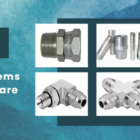In industrial steam systems, a condensate pot is a device used to gather and store condensate, or the liquid that is left over after steam condenses. It serves as a shield to stop harm from hot, high-pressure steam from getting directly in touch with the sensing element of devices like pressure transmitters and level gauges. In addition to offering a location for condensate sampling for analysis, the condensate pot facilitates the extraction of non-condensable gases. Condensate pots, which are usually positioned at low places in the steam system, keep instrumentation measurements accurate and consistent while guaranteeing condensate handling safety. They are essential to the protection of delicate equipment and the smooth running of steam systems.
Exploring The Different Materials Used In Condensate Pot Manufacturing
Mcneil Instruments Inc. is a manufacturer and exporter of condensate pots, serving customers in many nations throughout the world. The condensate pots are offered at affordable prices and are constructed from materials of the highest caliber. As one of the top producers of seal pots, we create condensate pots out of carbon steel, alloy steel, stainless steel, Monel, and Hastelloy.
The liquid that is left behind after steam condenses back into water is called condensate, and it is collected and stored in a condensate pot in steam systems. Condensate pots are usually positioned at low spots in the steam distribution system, where condensate can accumulate and drain away, or beneath steam-using equipment.
Condensate pots are an essential component in many industrial processes, used to collect and remove condensate from steam systems. These pots are typically made from a variety of materials, each with its own unique properties and benefits. In this article, we will explore the different materials used in condensate pot manufacturing and their advantages.
Stainless Steel – For Condensate Pot
Stainless steel is a popular choice for condensate pot manufacturing due to its durability and resistance to corrosion. It is also easy to clean and maintain, making it a cost-effective option for long-term use. Additionally, stainless steel can withstand high temperatures and pressures, making it suitable for use in a wide range of industrial applications.
Carbon Steel – For Condensate Pot
Carbon steel is another commonly used material for condensate pots. It is strong, durable, and can withstand high temperatures and pressures. However, unlike stainless steel, carbon steel is prone to corrosion and requires regular maintenance to prevent rusting. It is also more affordable than stainless steel, making it a popular choice for budget-conscious industries.
Monel – For Condensate Pot
Monel is a nickel-copper alloy that is highly resistant to corrosion and can withstand extreme temperatures and pressures. It is often used in harsh environments, such as offshore oil rigs, where corrosion is a major concern. Monel is also lightweight and has excellent mechanical properties, making it a popular choice for condensate pots in industries where weight is a factor.
Inconel – For Condensate Pot
Inconel is a nickel-chromium alloy that is known for its high strength and resistance to corrosion and oxidation. It is commonly used in high-temperature applications, such as in chemical processing plants and power generation facilities. Inconel is also highly resistant to cracking and can withstand extreme pressure differentials, making it a reliable choice for condensate pots.
Hastelloy
Hastelloy is a nickel-molybdenum-chromium alloy that is highly resistant to corrosion and can withstand extreme temperatures and pressures. It is often used in industries where corrosion is a major concern, such as in chemical processing and pulp and paper production. Hastelloy is also known for its high strength and durability, making it a reliable choice for condensate pots.
Titanium
Titanium is a lightweight and highly corrosion-resistant metal that is commonly used in condensate pot manufacturing. It is also biocompatible, making it suitable for use in industries such as pharmaceuticals and food processing. However, titanium is more expensive than other materials and may not be suitable for all applications.
Conclusion
There are several materials used in condensate pot manufacturing, each with its unique properties and benefits. When choosing a material for your condensate pot, it is important to consider factors such as corrosion resistance, temperature and pressure tolerance, and cost. By understanding the different materials available, you can make an informed decision and ensure the longevity and effectiveness of your condensate pot.
#condensatepot #stainlessstell #carbonstell #monel #inconel #hastelloy #titanium






